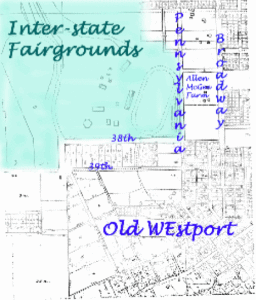KC Times, June 21, 1945
Kansas City Interstate Fairgrounds (1880s)
The fairgrounds ran from Thirty-eighth and Penn Streets (nobody called it Pennsylvania Avenue then) west to Roanoke Road and north to Valentine Road.  The racetrack was at Thirty-Eighth and Summit, running north. To make this track it had been necessary to grade and fill. That left a deep hollow in the middle of the race track over; the rains accumulated and first you knew, there was a year-round pond deep enough for luckless boys to drown in, and a few did.
The racetrack was at Thirty-Eighth and Summit, running north. To make this track it had been necessary to grade and fill. That left a deep hollow in the middle of the race track over; the rains accumulated and first you knew, there was a year-round pond deep enough for luckless boys to drown in, and a few did.
But that never discouraged other boys from going swimming there, with or without parental permission. Some of the boys Dixon remembers were Jack Ragan, Fred and Bert Duerr, and Julius and Mort Boeber. There were plenty more whose youthful faces came laughing back through a mist of years as a fellow sits in the living quarters of the grocery store his father started in 1884, and which he and his brothers closed three years ago under the duress of war shortages, OPA and rationing.
The fairgrounds was always a magnet to the boys of old Westport. Most of all of course it lured them the week the fair was on in the fall, which usually was shortly after school had opened. Farmers brought their prize livestock to exhibit, cows and steers calves, bulls, bulging hogs, yellow ears of corn and apples they hoped would win prizes. Women brought preserves made in busy kitchens on hot summer days, when the wise boy would keep out of his mother’s way and attract as little attention as possible. Those were good days for slipping off to the fairgrounds to go swimming.
Playing Hooky
The unfortunate clashing of dates between school and the fair, Mr. Dixon remembers with a mild twinkle of amusement, made it necessary to play hooky a good deal the week the fair was on. Because, unless a fellow played hooky, he had no opportunity to make a quarter of a dollar watching somebody’s team or buggy horse.
The great sophisticated world came to the fairgrounds for that week –race horses and ring games for prized of doubtful worth but ? none the less – bright-handled pocket knives that could never be anything but dull; brass jewelry to endear you to the hearts of girls, at least until their skin turned black or green from contact with the brass.
There was a jockey named Isaac Murphy who used to come to that fairground racing session, and everybody said he was one of the greatest jockeys in the world and what a thrill a boy got out of seeing Isaac Murphy up close and maybe hearing him say something.
Under the grandstand, which was on the west side of the race track, over toward Madison Street, the thirsty gathered to buy beer and whiskey. A boy could see them guzzling beer from the bottle and hopefully wait for someone to get in a fight, and someone usually did if you waited long enough. For this impulsion of hot weather and hot liquor brought differences of opinions to a brawling point, and a poke in the nose, and “rasaling,” cussing, grunting and rolling around. Usually bystanders broke up the fight before it got so bad that some “deppity” marshal had to take official action. But the “deppities” mostly were good fellows who were shunning, not seeking, opportunities to make arrests. When they were forced by circumstances to take somebody in tow, they usually turned him loose as soon as he had sobered up a little, unless he was an unusually quarrelsome sort of pest.
Imported Chariots
In addition to regular horse races, a man named Butler, who ran a saloon at Mill Street and Westport Avenue, imported chariots and chariot drivers to race at the fair in the Roman, or Ben Hur, or circus fashion. The chariots rumbled and kicked up a lot of dust, and watching boys whistled and yelled encouragement to their favorites. Life seemed awfully tame for a while when the fair’s too brief week had flashed to a close.
The grandstand was an elaborate 3-decker affair, surmounted by a cupola, and with the Roanoke woods forming a cool background behind it. The fairgrounds were laid out on farm land bought by Allen B. H. McGee, and many businesses contributed to the fair’s financial needs. The promoters were lavish in superlatives when it came to advertising the fair. A 2-column display advertising in the Kansas City Times, Aug, 23, 1883 advised:
Go to the greatest of them all!
After you have visited your County Fairs, your State Fairs and National Fairs, go to the Kansas City Interstate Fair, Sept. 17, 18, 19, 20, 21,22, 1883, where you can witness the grandest exposition of the Wealth and Industries of the Western States ever collected at any fair. An aggregation of Fleet-footed Horse, of Blooded Cattle, Sheep and Hogs, f Agricultural and Horticultural and Mineral Products, Agricultural Implements and Machinery and the most interesting races over the BEST RACE TRACK IN THE WORLD and from the finest grand stand in America! Address for information, M.J. Payne, General Manager.
Ran Excursion Trains
This was not Westport’s fair alone; the railroads ran excursion trains out from the old Union Depot on Union Avenue, meandering and climbing up from Southwest Boulevard by way of Roanoke Road. And that brought back to memory the days of John I. Blair and the Kansas City railroad that was going to run all the way to the Gulf of Mexico. Blair was a railroad promoter and builder who had a town called Blairsville named after him, over in Henry County, Missouri, northwest of Clinton.
Grading operations were started between Westport and Dedson, and eventually a track was laid. A tunnel was bored through a bluff in Roanoke, but so far as Mr. Dixon’s memory goes, it was never used because it was not braced and reinforced properly, and soon began to fall in. So the railroad company boarded up the mouth of the tunnel as tightly as possible. But no job of boarding up could keep adventure-hunting boys out of anything as exciting as a dark tunnel, where you had to take candle ends to find your way, and the water dripped down from above, and here and there a chunk of rock had fallen and you might find a robber’s gold or human skeletons at any time. Of course, you never did find any gold or any skeletons either, but that didn’t prove you might not find them that day.
The K.C. Osceola & Southern
Edward Dixon was about 15 years old, as he remembers, in the days when the Osceola & Southern Railroad was booming and was the talk of Westport. Young Ed thought he had a job clinched as a water boy for the railroad builders, and he was looking forward to what he would do with the fortune which was bound to accumulate at $1 as day six days a week. And then another boy underbid him for the water boy job – agreed to work six days a week for $5 and got the job and then – moral warning here, maybe – broke his leg. So Ed Dixon was glad he hadn’t gotten the job.
His father, Hugh Dixon, had been running a grocery store since 1864. Sometimes during fair week, his mother used to run a lunch stand at the fair. It doesn’t seem possible to anybody today, but at that time neither hot dogs or hamburgers were on lunch stand menus. The hungry brought a lunch –meat and potatoes and a vegetable and something sweet. If you wanted the real holiday spirit, you could also buy soda pop at the lunch stand, to wash down your lunch, and a large, fat shiny cigar, guaranteed to suffocate mosquitoes on contact. For cigars were the mark of adulthood and sophistication; men of the world in derby hats and horseshoe-spangled vests, rolled their cigars under their walrus mustaches, while boys looked on in admiration and planned to do likewise as soon as they could sprout mustaches.
